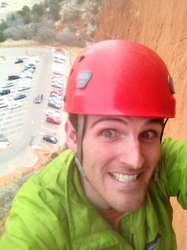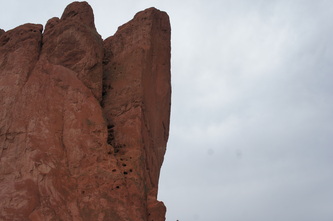Tower of Babel via Triple Exposure (5.4 C2 R)
Castle Rock, Douglas County via NE Ledges
March 8, 2013
Partner: Noah McKelvin
After having our plans to head to the Fishers thwarted by snow, Noah and I met in the Springs to climb Triple Exposure before the storm hit. We had the pleasure of meeting Stewart Green and had fun chatting with him for a bit. After the climb I stopped and hiked up Castle Rock on the way home. Here are my notes on Triple Exposure...
Triple Exposure
...
Approach: Easy as pie. Park at the main lot in the Garden and make the very short hike to the base, jumping the fence on route. The route is obvious.
Route:
P1 - 5.4 C1 R - Start by free climbing up the easy steps on the right. Work back left on small ledges and ascend up into a small constriction. One awkward move puts you back on another small ledge that works back right to the first fixed pin. Begin aiding up the steepening face on old pins,
over a small roof. Pass the old belay (not obvious) and move up into a small crack using pins and small nuts to reach a beefy chain
anchor. The start of this pitch is completely unprotected and although easy, a slip would be catastrophic. 130'
P2 - 5.4 C2 - Place a #4 to reach the first fixed pin. Follow the pins as they traverse left and then move up a steep muddy seam with eroded pins and
gear. Pass another old belay (again not obvious), and make a free move to reach the next pin. A reachy rightward traverse on more old pins
then leads straight up into the obvious notch above. A few feet of free climbing puts you at the anchor in the notch. The pins on this pitch
are much more questionable than the ones on P1. Be prepared to deal if one is missing. 120'
Scramble the few feet to the top.
Descent: Make 2 airy double rope rappels down the route.
Thoughts: This is an excellent aid route to practice for trips to the desert. The rock is soft and the fixed pieces are generally questionable. This combined with the steepness of the climbing makes for a "larger than life" experience.
Gear: This can be done with a single set of cams 0.5-4 and a set of nuts. Offsets could be useful but likely avoidable. Many draws for the large number of fixed pieces and a few screamers provide piece of mind on the sketchier pieces. We took 21 draws (including screamers) and used them all on each pitch.
Partner: Noah McKelvin
After having our plans to head to the Fishers thwarted by snow, Noah and I met in the Springs to climb Triple Exposure before the storm hit. We had the pleasure of meeting Stewart Green and had fun chatting with him for a bit. After the climb I stopped and hiked up Castle Rock on the way home. Here are my notes on Triple Exposure...
Triple Exposure
...
Approach: Easy as pie. Park at the main lot in the Garden and make the very short hike to the base, jumping the fence on route. The route is obvious.
Route:
P1 - 5.4 C1 R - Start by free climbing up the easy steps on the right. Work back left on small ledges and ascend up into a small constriction. One awkward move puts you back on another small ledge that works back right to the first fixed pin. Begin aiding up the steepening face on old pins,
over a small roof. Pass the old belay (not obvious) and move up into a small crack using pins and small nuts to reach a beefy chain
anchor. The start of this pitch is completely unprotected and although easy, a slip would be catastrophic. 130'
P2 - 5.4 C2 - Place a #4 to reach the first fixed pin. Follow the pins as they traverse left and then move up a steep muddy seam with eroded pins and
gear. Pass another old belay (again not obvious), and make a free move to reach the next pin. A reachy rightward traverse on more old pins
then leads straight up into the obvious notch above. A few feet of free climbing puts you at the anchor in the notch. The pins on this pitch
are much more questionable than the ones on P1. Be prepared to deal if one is missing. 120'
Scramble the few feet to the top.
Descent: Make 2 airy double rope rappels down the route.
Thoughts: This is an excellent aid route to practice for trips to the desert. The rock is soft and the fixed pieces are generally questionable. This combined with the steepness of the climbing makes for a "larger than life" experience.
Gear: This can be done with a single set of cams 0.5-4 and a set of nuts. Offsets could be useful but likely avoidable. Many draws for the large number of fixed pieces and a few screamers provide piece of mind on the sketchier pieces. We took 21 draws (including screamers) and used them all on each pitch.

































